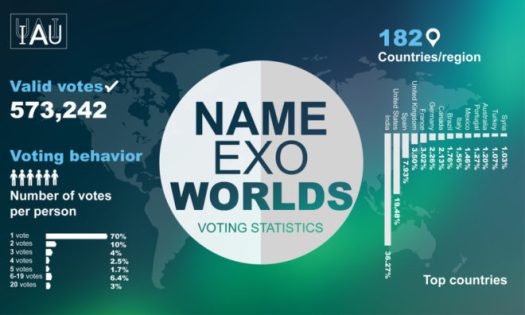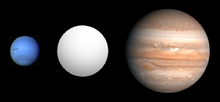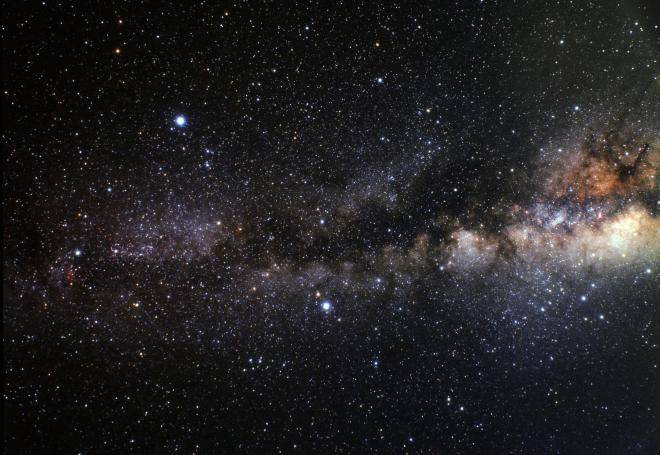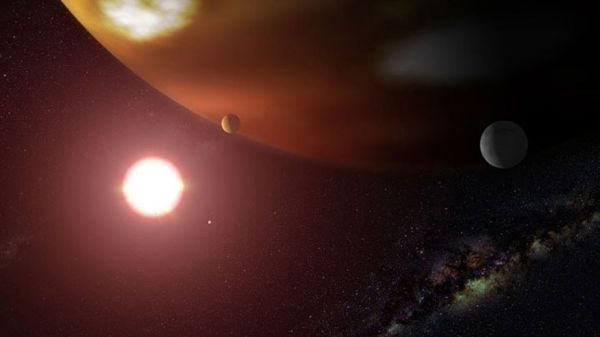
The name 51 Pegasi B, the first planet identified outside of our solar system, has been eclipsed. Now it is Dimidium.
The (at least) five planet system orbiting the star formerly known as 55 Cancri now circles the star Copernicus. And those planets 55 Cancri B, C, D, E, and F are Galileo, Brahe, Lippershey, Janssen and Harriot.
These are some of the 31 newly-named exoplanets and 14 newly-named stars, the result of an international naming competition organized by the International Astronomical Union and made public and formal last month.
More than half a million people voted in the naming sweepstakes, and that no doubt brought a lot of attention and interest into the world of exoplanet research. Organizers of the effort have explained their effort this way: “Given the publicity and emotional investment associated with these discoveries, worldwide recognition is important and the IAU offers its unique experience for the benefit of a successful public naming process.”
But a so far anecdotal survey of exoplanet scientists suggests that it will be a long time — if ever — before they use those IAU selected names.
For instance, Didier Queloz, who was part of the Swiss team that actually made that first discovery of 51 Peg b, is not at all impressed.
“‘Naming a planet” is mostly PR solely triggered by the (IAU) executive committee to engage with the public,” said Queloz, now of the Astrophysics Group of the Cavendish Laboratory in Cambridge, U.K. “Given the context of the exercise I think it is unlikely the community of professional will use any of these names. It is worth to keep in mind formally the concept of exoplanet is undefined by the IAU and the agreement on exoplanet definition is, I guess, a prerequisite to any formal naming scheme.”

While a name like HD 149026 b (now Smertrios) might be a turnoff to the public, it has been the name of a very important exoplanet since its discovery in 2005, and there is a deep scientific technical and even emotional connection to the old. So its new name will most likely have an uphill fight.
One of the co-discoverers of HD 149026 b is Debra Fischer, now a professor of astronomy at Yale University. Asked her view of the 31 new exoplanet names she replied:
“It would take a big push to change the names of exoplanets in the published literature. Every future publication would need to cross-list the former name(s) and this would be awkward and somewhat time consuming. Never say never, but it would require significant motivation for me to do this and I’m not feeling it right now.”
Jason Wright, an astronomer and astrophysicist at Pennsylvania State University, said that doesn’t expect the new names to catch on — with exoplanet scientists, with academic journals, and as a result probably not with the public. Wright is one of several who maintain exoplanet databases and who sent a letter to the IAU in 2013 questioning its proper role in exoplanet naming.
“As part of the IAU’s traditional role in setting standards for nomenclature, they are solving a problem that doesn’t exist, with little or no buy-in from the stakeholders — both exactly the opposite of what they should be doing as a professional society,” he said yesterday. “I applaud the IAU for its public outreach efforts here, but I’m very annoyed with the way they’ve sold this to the public and not included the exoplanet community in the process.”
In fairness, the IAU does not say that the former names should be avoided or demoted — unlike the 2006 IAU decision to formally strip Pluto of its planet status, making it a “dwarf planet.” As the organization puts it, “The winning names are to be used freely in parallel with the existing scientific nomenclature, with due credit to the clubs or organizations that proposed them.” The group also acknowledges that it doesn’t have a monopoly on exoplanet naming.
Addressing the concerns of the scientific community, IAU Executive Committee member Thierry Montmerle said that discoverers of the named planets were contacted at the beginning of the process “and most of them expressed that they were enthusiastic about it; they provided comments on their discovery, which were published from the start on the NameExoWorlds web page.
“The (IAU) Working Group also agreed that the public names would never supersede the scientific designations. This has been recalled many times at each step.”
(Montmerle’s full response has been provided in the subsequent Many Worlds post, “The IAU on ExoNames.”)

The ExoNames do have their supporters. Franck Marchis is a planetary scientist and chair of the exoplanet group of the SETI Institute, and he sees real value in the new names.
“It’s part an inherent part of exploration of putting names on maps, even if those names may look silly in the future. The naming of those worlds has a significant psychological impact, we basically make them real, and more accessible to the public who can now talk about them without having to look through a nomenclature of random letters and numbers,” he said.
“I predict that they will be a lot of projects in school on the names of 55 Cancri planets (Galileo, Brahe, Lippershey, Janssen and Harriot) and on the discovery of Dimidium. If one of those kids got interested in science because of these names, we succeeded.”
So will they be used at all? Greg Laughlin, an astronomer at the University of California, Santa Cruz, has started an online poll to see what scientists, and the public, think about whether the new names will be used.
His site is called Metaculus (http://www.metaculus.com/questions/38/) and it asks this question: “Will the IAU-sanctioned Exoplanet Names come into regular use?”
The number of respondents has been limited, but the answer so far has been a resounding “no.”

Laughlin says he has nothing in particular against the names chosen — okay, he does say that some are pretty silly — but he does believe it is way too early to be naming the exoplanets at all. We know too little about them at this point to give appropriate names, he says, and so there’s only a slim chance that they will last. “Really, what we have about exoplanets is preconceptions,” he said.
To make his point — one he first made in 2008 — he harkens back to a passage in the Ray Bradbury classic, “The Martian Chronicles.” In it, the colonizing Earthlings give names to Martian locales that reflect their own realities and aspirations. But the names have nothing to do with the planet, or with the longtime Martian inhabitants who — in “The Chronicles” at least — had lived there for eons.
As Bradbury wrote:
“The old Martian names were names of water and air and hills. They were the names of snows that emptied south in the stone canals to fill the empty seas. And the names of sealed and buried sorcerers and towers and obelisks. And the rockets struck at the names like hammers, breaking away the marble into shale, shattering the crockery milestones that named the old towns, in the rubble of which great pylons were plunged with new names: Iron Town, Steel Town, Aluminum City, Electric Village, Corn Town, Grain Villa, Detroit II, all the mechanical names and the metal names from Earth.”
Laughlin followed the Bradbury quote by saying that “I think we’ll eventually reach the extrasolar planets, and in so doing, we’ll find out what their true names are.” His views haven’t changed.

The question of naming exoplanets is not a new one, and there is a clear logic behind trying to come up with something in addition to the likes of PSR 1257+12 (now Poltergeist.)
Public interest is essential to continued exoplanet research, especially when it comes to paying for the space and ground telescopes needed to make progress in the future. And as researchers acknowledge, the hugely successful New Horizons mission to Pluto — approved in the 1980s — would probably never have taken place if the planet had already been demoted to a “dwarf planet.” Names matter. And while the exoplanetary descriptors given by scientists work well for them, they can leave non-scientists cold and uninterested.
An additional concern at the time was the emergence of groups offering exoplanet naming rights for a fee. So the IAU asked one of its bodies, Commission 53, to look into the issue.
Unable to see a good way to change the naming regime, their 2012 final report reads:
“In the last several years the C53 discussed and debated at some length several issues regarding the nomenclature for newly discovered extrasolar planets. The first issue arose as a result of a detailed paper written by W. Lyra proposing a scheme for naming exoplanets by using a number of names from the classical (Greek, Latin) literature, rather than by the more mundane, but functional, current system of using the star’s name (e.g. 51 Peg) followed by lower case letters, in order of discovery, e.g., 51 Peg b, c, d.
The C53 decided against changing the current system of naming exoplanets, which is geared toward the clarity of astronomical databases of stars and exoplanets.”
This issue of clarity is quite significant since there are already more than 2,000 confirmed exoplanets, and more than 500 solar systems with more than one exoplanet. Both numbers are expected to grow rapidly in the years ahead since there are an essentially infinite number of exoplanets out there. So the exoplanets named so far are only a small pool in an ever expanding ocean.

Nonetheless, the IAU executive board rejected the Commission 53 conclusions and set up the international naming contest that concluded in December. Among the new names: Tadmor (Arabic for the ancient city of Palymra), Draugr (an “undead” creature in Norse mythology), Quijote (the famed literary tilter at windmills) and Taphao Thong (one of two sisters in a Thai folk tale.) For a complete list of new exoplanet and star names, go to: http://nameexoworlds.iau.org/names
The chair of the original Commission 53 committee, Alan Boss of the Carnegie Institution for Science’s Department of Terrestrial Magnetism, was among those overruled, but is not embittered because he does not envision much change. “Yes, it is fun for the public to get involved,” he wrote in an email, “But I expect that most astronomers will at best put these names in parentheses in their published work, and continue to focus on the usual astronomical nomenclature.”
Dimitar Sasselov of the Harvard-Smithsonian Center for Astrophysics had a slightly different take on the namings:
“Yes, there is not much enthusiasm to learn and use these names but perhaps they’ll appeal to future users,” he wrote. “I can imagine how one of those ‘named’ planetary systems becomes the focus of intense attention due to a discovery – say of an Earth-like planet with an interesting atmosphere. It is possible that the discoverers might decide to use the new name(s) as a convenient shorthand, then everyone else might start using it. But short of that, I do not see me or my colleagues using these new names.
“On the other hand, it is good that IAU is doing it – or else we might have ended up with who knows what names.”


Dear Marc,
Lars forwarded your article to us.
We found it quite interesting, since, for once, it concerns the feedback from the astronomers’ community, which is certainly as important for us as the reactions from the public.
We do have a few comments to offer, that may supplement your already rich article.
They are listed below.
Many thanks for you interest in the IAU and in the “NameExoWorlds” contest !
1) The exoplanet community has been involved from the start. IAU Commission C53 set up a Working Group including, among others, Didier Queloz and Geoff Marcy. This Working Group made the recommendation for defining the initial list of 305 confirmed exoplanets for public naming. They also agreed that the names could be given by the public (not by the discoverers or scientists), with the aim of having various names representing different cultures all over the world. Given the results of the contest, it is obvious this goal has been successfully reached.
The discoverers of the named planets have also been contacted at the beginning of the process and most of them expressed that they were enthusiastic about it; they provided comments on their discovery, which were published from the start on the NameExoWorlds web page.
The Working Group also agreed that the public names would never supersede the scientific designations. This has been recalled many times at each step.
2) Astronomy clubs and associations were invited to engage into the contest by voting for the top “most popular” systems (i.e., most interesting in their opinion). As a result, we decided to select the top 20 for naming proposals by the public. The resulting list is remarkably diverse and reflects rather closely the wide range of the present-day “exoplanet science” (restricted to confirmed objects having been studied for many years, not to recent “frontier” objects like the Kepler exoplanet candidates).
3) All the names (including star names) were the subject of 275 argued proposals sent by over 600 registered clubs, then submitted to a public, worldwide vote, and over 500,000 were cast by voters from 180 countries. The contest also generated over 800 articles in 54 countries. Thus the large impact of the contest on the public across the world is undeniable.
Also, we have seen in many occasions that the contest gave the opportunity to the astronomical associations to address locally the non-specialist public at large about stars and planets. In this regard, the contest in itself is also a success in arousing a wider interest for astronomy.
4) Whether or not the scientific community uses these names is actually irrelevant, this has never been the purpose of the contest. Professional astronomers still use concurrently common “nicknames” and scientific designations for astronomical objects: alpha CMa and Sirius, M42 and Orion, NGC7293 and the Helix Nebula, M31 and the Andromeda galaxy, etc., but the public certainly prefers to use the nicknames when they exist.
The fact is the names approved by the IAU are already quoted in Wikipedia, so the public will very likely use them whenever an opportunity arises.
5) On the other hand, the public names are now officially sanctioned by the IAU and included in the SIMBAD database (and are in the process of being included in other professional databases).
6) We’ll see in the long term whether the names are caught up by the public in general, but in our opinion it will be more a matter of the future scientific interest of the objects themselves (exoplanets and/or stars) than of their public name.
There is little doubt that any future press release on HD149026b, for instance, even if written by scientists, will speak about the planet “Smertrios” rather than use the scientific “license plate” designation.
LikeLike
Ah come on you old fuddy-duddy scientists. The public loves the names. And ultimately your funding comes from the people. Have fun and adopt these new names. Cross-referencing will take only seconds of time.
LikeLike
Marc, do you know if any of this kind of controversy came about during the naming of geographic features on the Moon?
LikeLike
Regrets for the belated response, Ken. As far as I know, there have not been significant controversies over features on the moon. But they certainly have occurred elsewhere. Here is a fun recounting by Laurance Doyle, who was on the imaging team for the Voyager mission as it passed Uranus. He also tells of other naming issues at http://www.space.com/773-moon.html
“A colleague of mine, Bruno Sicardy (of Observatoire de Paris) and I noticed that on a particular long exposure of the rings of Uranus taken by the Voyager spacecraft that one of the stars did not seem to be moving in the same direction as the others. “That’s a new moon” we said, but our colleagues doubted this, indicating that it was probably one of the known moons or that perhaps we had mistaken its motion. With the help of navigation calculations done by Steve Synott at Jet Propulsion Laboratory (one of the navigation team), we obtained a prediction as to when the moon, if real, would be seen in any additional pictures coming in from the Voyager imaging system. If real, such images would appear again going across the field of view in the pictures being transmitted the very next morning. I got caught up in traffic early the next day, but when I got in folks on the Voyager Imaging Team greeted me with, “Congratulations! You’ve discovered a new moon!” Yippee! Bruno and I had discovered whole new tiny little world!
We called my brother, who was well acquainted with Shakespearean literature, and the decision for a suggested name rested between “Mab” and “Peaseblossom” both fairies from Shakespeare’s “A Midsummer Nights Dream”. We suggested the name “Peaseblossom” then, which was well received by the scientists on the Voyager imaging team. Ah, but a controversy arose about the names of the new Uranian moons when a congressman, a few weeks later, suggested that the newly discovered moons of Uranus be named after deceased astronauts –a suggestion that soon drew a reply from the then Soviet Union pointing out that naming them after deceased cosmonauts was equally valid. This, then, actually started a bit of an international scuffle! Thus no name was assigned to our little “Peaseblossom” for several years.
Finally the name “Bianca”, a Shakespearean character from Taming of the Shrew, was quietly chosen by the IAU committee on naming moons and in the Smithsonian Institution in Washington D.C. you will see that the Voyager spacecraft is (really rightly so) credited with discovery of a little Uranian moon named “Bianca” about 20 kilometers across. Ah well, I still like the name “Peaseblossom” and nothing, to my knowledge, is yet named “Peaseblossom” in the heavens. However, Shakespeare is still a daily part of my life, as I have named the computer on my desk “Peaseblossom.” It is there to remind me that Bruno and I were the first ever to know of a wholly new little world. And when I remember the thrill of that discovery, by any other name, it still smells as sweet.”
More recently, we saw how formal names often give way to what scientists/explorers prefer. For 3 1/2 years now, the Curiosity rover has approached and explored a large mountain in the center of Gale Crater on Mars. The mound is officially called Aeolis Mons, but it is almost always called Mt. Sharp — named after a pioneering geologist and planetary scientist, Robert Sharp.
LikeLike